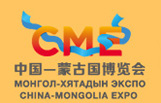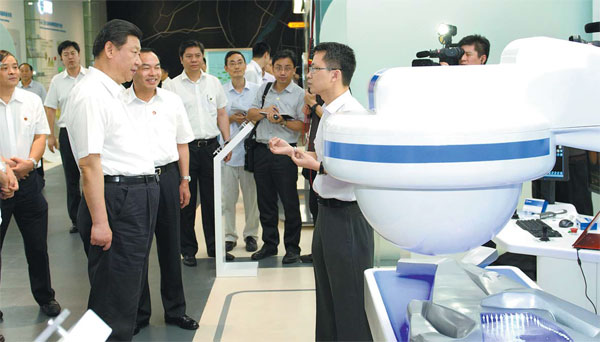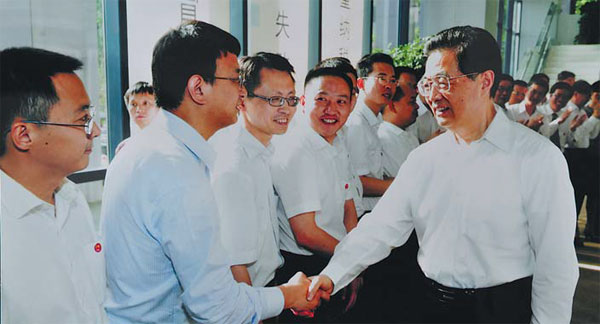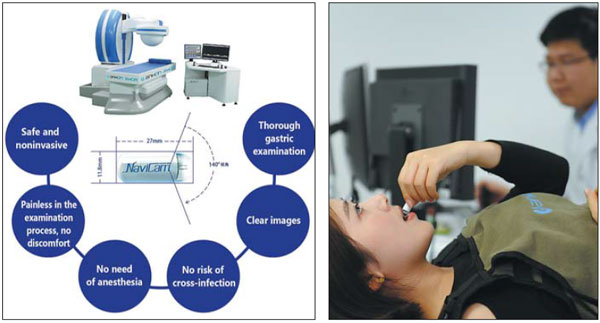NaviCam opens new healthcare era
By Zhuan Ti (China Daily)
Updated: 2015-12-16
|
Xiao Guohua, one of the founders of Ankon Technologies Co Ltd, explains the company's NaviCam system to President Xi Jinping on July 21, 2013. Photos Provided to China Daily |
|
Former president Hu Jintao meets the Ankon work team in Wuhan on June 1, 2011. |
|
Left: An illustration shows the NaviCam system and its advantages. Right: A patient swallows a capsule containing a "camera" and "light" that will provide a gastric examination for diagnosis and early screening. |
Technology expected to increase survival rate for gastric cancer patients
Continuous innovation and advanced technology helps improve healthcare delivery, makes it available to more people and increases healthcare outcomes and the quality of life for patients worldwide.
One of the latest medical technologies is a magnetically controlled capsule endoscope system, which not only reduces pain and discomfort for patients but also greatly improves treatment efficiency.
The system, called NaviCam, was developed and commercialized by Ankon Technologies Co Ltd, located in the Zhangjiang National Innovation Demonstration Zone.
As the world's first magnetically controlled capsule endoscope system, NaviCam received approval from the China Food and Drug Administration in 2013, and expects to open a new era of gastric diagnosis and early screening.
"The precise control and positioning functions of NaviCam ensures a complete examination of the stomach," said Ji Pengsong, president of Ankon. "The complete gastric examination can be done in as quickly as 15 minutes.
The developer said the medical capsule robot is an innovation that combines cutting-edge technologies such as sensors, optical imaging, imaging processing, wireless communications and device packaging.
The robot is made of more than 300 parts and combines over 40 international technological patents. The technology is three to five years ahead of the rest of the world, the developer said.
The robot weighs less than 5 grams and looks like a medicine capsule so patients can swallow it with water. The robot takes photos automatically as it passes through the body and is expelled through a bowel movement. There is no adverse reaction and patients do not require anesthesia.
The NaviCam system includes many breakthroughs that greatly improve the efficiency and effectiveness of inspection. For example, a coating technology was developed to protect the camera lens to ensure the imaging is clear and precise.
In addition, the unique magnetic sensor technology of NaviCam means there is no need for an X-ray examination to determine if the capsule is still inside the body when the inspection is finished.
The patented positioning and five-dimensional active magnetic control technologies of NaviCam can also diagnose both intestinal and gastric diseases.
The entire inspection procedure is convenient and comfortable, especially for sensitive people, such as children, the elderly, or patients with cardiovascular diseases, developers said.
In a double blind clinical trial conducted in seven leading Chinese hospitals including Changhai Hospital in Shanghai and Beijing 301 Hospital, Ankon's NaviCam's disease diagnostic accuracy rate reached 93.4 percent and its sensitivity was 90.4 percent, which suggests NaviCam is a reliable tool in the examination process.
The rates, released at the 2015 National Academic Conference of Digestive Endoscopy in November, also suggest NaviCam is an ideal supplement to traditional gastroscopy.
The global incidence of gastric cancer is declining, but it remains highly prevalent in Asian countries, especially in China. China is one of the countries with the highest incidence of gastric cancer and accounts for more than 40 percent of all new gastric cancer cases worldwide, health figures show.
Gastric cancer is one of the leading causes of cancer mortality in China. Each year, the country sees about 400,000 new cases and about 350,000 mortalities.
The survival rate over five years for advanced gastric cancer is less than 30 percent while the rate exceeds 90 percent if the disease is detected in the early stage. Most cases are not found until the advanced stage, leading to high mortality, because the early symptoms of gastric cancer are seldom obvious.
In China, the cure rate of early gastric cancer is less than 10 percent, much lower than the 70 percent in Japan and 50 percent in South Korea.
Experts said the absence of effective tools and mechanisms for early screening is the main reason for the difference.
In the past, the gastric cancer was mainly detected through gastroscopy, for which many patients had poor tolerance. Most gastric cancer cases found by that method were in the middle or advanced stages, meaning patients had passed the optimum treatment time.
The world's first magnetically controlled capsule endoscope system developed by Ankon is suitable for regular stomach health checks and early stomach tumor screening. Promising a painless, noninvasive and infection-free experience, the system provides a more effective early screening tool for gastric and digestive diseases, medical experts said.
The system has already been widely used in more than 100 hospitals and medical centers across China.
According to the company, it will be available in about 500 hospitals and medical centers in 2016, including in second- and third-tier cities.
As the use of such advanced technology widens, more clinical physicians urgently need to understand and master such systems. A book, Atlas of Remote-controlled Capsule Endoscopy in Digestive Tract, written by experts in the digestive endoscopy field in China, was released this year. The book includes more than 200 photos of healthy and diseased digestive tracts taken using Ankon's NaviCam. It is intended to give guidance to physicians in their practice.
According to the company, more innovative medical equipment and facilities to treat stomach and digestive diseases are being developed.
For example, the company is working on the development of a robot that can treat constipation and improve the intestinal environment.
A measurement instrument for gastric dynamics is expected to go on the market in 2017.
In addition, the company is also carrying out studies on surgical robots, which would be used for surgery requiring minimal invasion. One such robot is undergoing clinical trials.
"So far, we are working on establishing a nationwide medical network to unite experts and scholars in digestology and work as a platform for medical services and improvement of digestive diseases," said Ji.
Ankon has developed an Internet cloud service platform based on NaviCam and aims to develop a smart medical system to better serve patients. Through this, patients will be able to reserve an examination in one hospital and choose an expert in another hospital to diagnose the results. Patients will even be able to send their results to an expert online and receive a diagnosis.
The unique Internet-based system will separate examination service providers and experts so leading experts in the field can serve more patients.
The company said such an online diagnostic and service platform allows medical service providers to share information and enhance their working efficiency.
The company also plans to pay more attention to a health-related big data system to provide premium medical services.
Ankon is a typical case of scientific innovation in the Zhangjiang National Innovation Demonstration Zone, which was approved by the State Council in 2011.
Focused on innovative development and boosting economic transformation, the Zhangjiang zone has constantly worked to build an innovative ecological system, cultivate new industries and attract skilled talent globally.
The zone has launched a series of pilot reform measures, which have played an important role for Shanghai to establish itself as a scientific innovation center with global influence.
The Zhangjiang National Innovation Demonstration Zone houses nearly 70,000 enterprises, of which more than 2,800 are high-tech enterprises, more than 1,400 are research institutions and over 300 are public service platforms. Its accumulated invention patents exceed 32,000, which has laid a solid foundation for the city to become a science and technology innovation center by 2020.
zhuanti@chinadaily.com.cn
(China Daily 12/16/2015 page28)

Mongolian doll goes global
The figurine dressed in traditional Mongolian clothing has been getting the attention of doll collectors from China and abroad.



